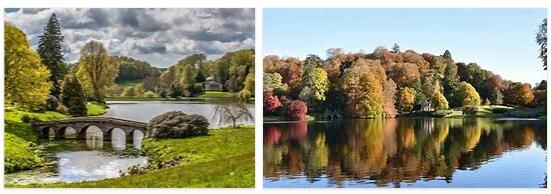Stonehenge
On many trips to Great Britain, the English south coast with the seaside resorts of Bournemouth and Plymouth is a popular holiday destination. A little further inland is the county of Wiltshire, which is particularly interesting for study travelers. In the hilly region between Mendip Hills, Salisbury Plain and Cotswolds, numerous prehistoric sights such as ramparts, barrows and stone circles can be visited, with the stone circle of Stonehenge in particular being a cultural object of world renown. The Stonehenge plant is located near Amesbury around 13 km north of Salisbury; As the largest prehistoric structure in Europe, Stonehenge and its surroundings were declared a UNESCO World Heritage Site in 1986.
An enigmatic destination – Stonehenge
The construction of the Stonehenge complex began in the Middle to Neolithic Age (8000-4000 BC); the entire construction phase with three sections lasted around 2,000 years. The complex consists of an outer wall or ditch (diameter 115 m), which surrounds several concentric stone circles; In addition, the complex contains individual monoliths and position stones with special functions (including altar stone, sacrificial stone, heel stone). All stone circles are formed by triliths, each of which has two bearing stones connected by a capstone. The distinctive sight of Stonehenge is shaped by the outer circles made of the “sarsen stones”; these sandstone blocks weigh 25-50 tons and come from a quarry near Marlborough 30 km away. The material for the inner stone circles has been proven to come from the Welsh Preseli Hills (distance 380 km); these “bluestones” are the coarse-grained basalt variety dolerite. Access to the inner circles is from the northeast (main entrance) or south (secondary entrance); A road led from the Stone Age complex to the Avon River (Stonehenge Avenue) during construction. Stonehenge has been a British state property since 1918 and is one of the main tourist attractions on the island. As a measure against souvenir collectors, the complex may only be visited on designated paths, but Stonehenge is an impressive and at the same time enigmatic monument. Access to the inner circles is from the northeast (main entrance) or south (secondary entrance); A road led from the Stone Age complex to the Avon River (Stonehenge Avenue) during construction. Stonehenge has been a British state property since 1918 and is one of the main tourist attractions on the island. As a measure against souvenir collectors, the complex may only be visited on designated paths, but Stonehenge is an impressive and at the same time enigmatic monument. Access to the inner circles is from the northeast (main entrance) or south (secondary entrance); A road led from the Stone Age complex to the Avon River (Stonehenge Avenue) during construction. Stonehenge has been a British state property since 1918 and is one of the main tourist attractions on the island. As a measure against souvenir collectors, the complex may only be visited on designated paths, but Stonehenge is an impressive and at the same time enigmatic monument.
Stonehenge – cult place or calendar
The archaeological investigations show a large number of cremations in Stonehenge; the last historical cult act is dated to the 7th century. The size of the complex indicates the importance of the buried; they were probably members of a previous ruling family. In addition to being used for sacrificial and burial ceremonies, the stone circles may also have served as a meeting place for priests on certain days. The exact time of this meeting can be determined from the shadow cast by the heel stone and the position stones, as these are exactly aligned with the beginning of spring or autumn (equinoxes). Stonehenge can therefore be called a calendar or a place of worship, but one meaning is certain – a magical place.
Stourhead
The Stourhead property is in the south of England in the county of Wiltshire. It is around 40 km from Bath and just 180 km from London and is one of the most beautiful sights in the picturesque region.
Stourhead is an imposing neo-Palladian country house built by Sir John Stourton from 1448. One of the most impressive English landscape parks in Great Britain extends around the country estate and is not only very attractive for the English. Study travelers from all over Europe come to Stourhead to experience this special landscape garden.
Stourhead Gardens: Greek mythology in a fantastic natural setting
Stourhead Garden has an area of around 1.1 hectares with a lake in the center. It is dammed up from the source of the River Stour. There is a scenic circular route around the lake to all of the park’s attractions. In the middle of the 18th century, the Flora Temple, the Nymph and River God Grottoes and the striking Pantheon were built. Inside, visitors will find several statues with Greek deities, such as Hercules, the son of a god, and Flora, the goddess of spring.
A little off the beaten track on a hill stands the Apollon Temple, which is said to be one of the most impressive temples in the world. From there you have a fantastic view of the surrounding area. From the Palladian bridge there is a line of sight to the village, which is picturesquely integrated into the park.
The garden is open all year round. Guided tours are organized in the country house. A visitor center provides information on the history of the property as well as the landscape architects who worked on the park.
